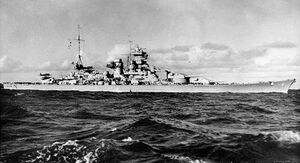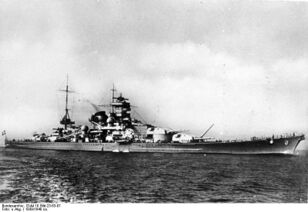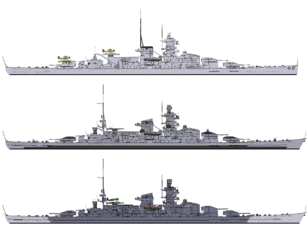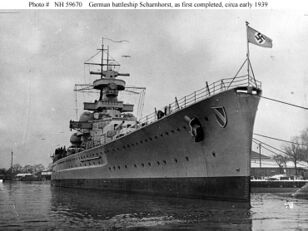Scharnhorst
| Scharnhorst | |||
|---|---|---|---|
 | |||
| Tekniske data | |||
| Lengde (m) | 231 | ||
| Bredde (m) | 30 | ||
| Dypgående (m) | 9,9 | ||
| Toppfart (knop) | 32 | ||
| Motor | 12 boilers, three Brown-Boveri turbine sets, 160,060 hp | ||
| Tonnasje | 32700 brt | ||
| Deplasement | 38,430 mt | ||
| Mannskap | 1,968 | ||
| Karriere | |||
| Rederi | Kriegsmarine | ||
| Bygget | 15 Juni 1935 Wilhelmshaven ved Kriegsmarinewerft | ||
| Flaggstat | Tyskland | ||
| Dykket | |||
| Dykkedybde | 290m | ||
| Posisjon | 71.430678 N, 25.795898 E | ||
|
Karthjelpen:
| |||
Historie [1]
Den tyske slagkrysseren Scharnhorst gikk ned etter harde kamper mot Allierte marine enheter den 26 desember 1943, nærmere 66 nautiske mil nord for Nordkapp. Slaget er i historien ofte referert til som "Slaget ved Nordkapp" etter tyskernes navngivelse av hendelsen som "die Tragedie vor dem Nordkap". Av den store besetningen ombord på Scharnhorst, overlevde kun 36 mann slaget og det kalde vannet. En stor skyld i så få overlevende må tildeles de Allierte skipene som etter å ha senket slagkrysseren trakk seg unna området, og overlot en stor andel tyskere til å fryse ihjel i det kalde vannet. Scharnhorst`s historie er full av aktiv deltagelse under den andre verdenskrig, og de kanskje best kjente hendelser var senkingen av de Britiske skipene HMS Glorious den 8 juni 1940, hjelpekrysseren Rawalpindi i November 1939 og hjemkomsten etter Günther Priens modige oppdrag under senkingen av HMS Royal Oak i Scapa Flow i oktober 1939 med sin U 47. Scharnhorst opererte også flere ganger med sitt søsterskip Gneisenau og andre store marinefartøyer i de nordlige farvann. En stor andel med informasjon om Scharnhorst kan søkes opp på Internet for de som vil ha mer utfyllende historikk om Scharnhorst. Etter senkingen ble skipet bare et nytt kapittel i historiebøkene, frem til vraket ble funnet av det Norske forskningsfartøyet HU Sverdrup. Scharnhorst ble senere filmet med en ROV fra det Norske mairnefartøyet KNM Tyr, og opptakene ble fremvist i en dokumentarfilm under NRK`s program "Brennpunkt" i 2000. Vraket av Scharnhorst hviler opp-ned på en dybde av 290 meter, sterkt skadet etter kampene i 1943. Seksti meter av baugen er revet vekk fra resten av vraket.
Posisjon i Google Maps er kun omtrentlig posisjon.
A short history
June 1935: Lay down at the Kriegsmarinewerft shipyard in Wilhelmshaven. Slipway 2. 03 October 1936: Launched. 07 January 1939: Commissioned under Captain Otto Ciliax. July-August 1939: Reconstruction at Wilhelmshaven Naval Dockyard. The straight stem is removed and replaced by an Atlantic bow. In addition the hangar is enlarged and equipped with a new catapult. The mainmast in the funnel is removed and placed astern of the hangar. 23 October 1939: Welcomes U-47 (Lieutenant Günther Prien) after its successful attack in Scapa Flow with the crew at quarters in Kiel. 21 November 1939: Departs Wilhelmshaven with her sister-ship Gneisenau under the command of Vice-admiral Wilhelm Marschall. 23 November 1939: At 2000, sinks the 16,697-ton British auxiliary cruiser Rawalpindi (Captain Edward Kennedy). The Scharnhorst is hit by a 152mm projectile from the Rawalpindi but the damage is insignificant. Picks up 27 survivors. 27 November 1939: At midday arrives at Wilhelmshaven. December 1939-February 1940: The MES (Magnetischer Eigenschutz) "magnetic self-protection system" is installed, and a new FuMO 22 radar set is mounted on the foretop platform. 18-19 February 1940: Short sortie in the North Sea. 06 April 1940: Operation Wesserübung. At midnight, leaves Wilhelmshaven with Gneisenau as the cover force of "Group I" for the invasion of Norway. 09 April 1940: Around 0400, some 50 miles off Narvik, Scharnhorst and Gneisenau under the command of Vice-Admiral Günther Lütjens, are engaged by the British battle cruiser Renown. In a brief exchange of fire the Gneisenau receives three 38cm hits and the Renown two of 28cm. 04 June 1940: Operation Juno. At 0700 leaves Kiel with Gneisenau, the heavy cruiser Admiral Hipper and the destroyers Erich Steinbrink, Hans Lody, Hermann Schoemann, and Karl Galster. 08 June 1940: At about 1600, the Scharnhorst sights the British carrier Glorious (Captain D'Oyly-Hughes) escorted by the destroyers Acasta (Comander Charles Glasfurd), and Ardent (Lieutenant Commander J. F. Barker). At 1632 opens fire from 26,000 meters (28,500 yards). Six minutes later at 1638, from 24,000 meters (26,300 yards) the Glorious is hit in the flight deck starting a fire. Gneisenau opens fire at 1642, and a few minutes later the Glorious is hit again in the bridge killing the Captain and most of the personnel there. At 1656, Scharnhorst and Gneisenau cease fire temporarily due to smoke screen launched by the escorting destroyers. Thereafter, the Ardent launches eight torpedoes but obtains no hits and is sunk by the combined fire of both German battleships at 1725. The Glorious comes again under fire, and at 1720 she is hit in the centre engine room. Meanwhile, the Acasta closes on and obtains a torpedo hit on Scharnhorst at about 1730. The torpedo tores a hole of 14x6 meters in the hull, and 2,500 tons of water get on the ship. As a consequence of this torpedo hit the after 28cm turret is put out of action, and 48 men die. Heavily damaged the Glorious capsizes and sinks at 1810. The Acasta finally sinks at 1820. In all more than 1,500 British sailors died. During this action Scharnhorst expends 212 x 28cm and 842 x 15cm shells. 09 June 1940: In the afternoon, Scharnhorst and Gneisenau arrive at Trondheim. June-December 1940: Repair work at Wilhelmshaven. 23 January 1941: Operation Berlino. Departs Kiel with Gneisenau under the command of Admiral Günther Lütjens. 28 January 1941: Scharnhorst and Gneisenau sight the British cruiser Naiad in the Iceland-Faroe strait and turn around. 5 February 1941: Scharnhorst and Gneisenau enter the Atlantic through the Denmark Strait, and refuel from tanker Schlettstadt some 150 miles south of Cape Farewell. 8 February 1941: Sights convoy HX-106 escorted by the battleship Ramillies. Therefore Admiral Lütjens breaks contact. 14 February 1941: Scharnhorst and Gneisenau refuel from tankers Esso Hamburg and Schlettstadt. 22 February 1941: Scharnhorst and Gneisenau sink the British merchantmen Kantara (3,240 tons), Trelawney (4,690 tons), Huff (6,200 tons), tanker Lustrous (6,156 tons), and Harlesden (5,500 tons). 27 February 1941: Scharnhorst and Gneisenau refuel from tankers Ermland and Friedrich Breme and head to the Canary Islands. 06 March 1941: Scharnhorst and Gneisenau meet with U-124 (Lieutenant Wilhelm Schulz). 07 March 1941: Scharnhorst and Gneisenau sight the battleship Malaya that together with other cruisers escorts convoy SL-67 of 58 ships. Lütjens reports the position of the convoy to the U-boats that sink the Hindpool, Lahore, Harmodius, and Nardana, with a total tonnage of 28,500 tons. In the next eight days U-105 and U-106 sink seven more ships and score a torpedo hit in Malaya that heads to New York via Trinidad for repairs. 09 March 1941: Sinks the Greek merchantmen Marathon (6,350 tons). 11-12 March 1941: Scharnhorst and Gneisenau refuel from tankers Ermland and Uckermark. Conference held on board Gneisenau with the Captains of both battleships and the tankers. 16 March 1941: Scharnhorst and Gneisenau capture or sink the British merchantmen Simnia (6,200 tons), San Casimiro (8,050 tons), British Strength (7,140 tons), Athelfoam (6,550 tons), and the Norwegian Bianca (5,700 tons) and Polykarb (6,400 tons), all from a dispersed convoy. Aproximate position 40° 30' North, 43° 45' West. The search continues and later in the day they sink the Norwegian Granli (1,580 tons), the British Demeterton (5,250 tons), Sardinian Prince (3,490 tons), Silverfir (4,350 tons), Royal Crown (4,360 tons), Empire Industry (3,650 tons), and Rio Dorado (4,500 tons), the French Myson (4,560 tons), the Dutch Mangkai (8,290 tons), and the Danish Chilean Reefer (1,830 tons). 22 March 1941: Scharnhorst and Gneisenau enter Brest. March-July 1941: Develops problems with her engines and enter the dry dock for repairs. 24 July 1941: Hit by five bombs while testing the machinery at La Pallice. 3,000 tons of water get on ship and the damage is considerable. August-December 1941: Repair work. 11-13 February 1942: Operation Cerberus. Leaves Brest with Gneisenau and the heavy cruiser Prinz Eugen <peugen.html> escorted the destroyers Paul Jakobi, Richard Beitzen, Friedrich Ihn, Hermann Schoemann, Z-25, and Z-29 for a dash through the English Channel. Group commanded by Vice Admiral Otto Ciliax. Scharnhorst strikes two mines while passing through the English Channel but enters Wilhelmshaven on the 13th. 9 January 1943: Leaves Gotenhafen for Norway together with the Prinz Eugen <peugen.html> and three destroyers. Detected by British planes on the 11th, the group returns to Gotenhafen where it arrives on the 12th. 23 January 1943: Sails for Norway again with Prinz Eugen but is detected one more time by British planes and therefore returns to the Baltic. March 1943: Departs Gotenhafen for Altenfiord (Altafjord) in north Norway where she is to join the battleship Tirpitz <tirpitzi.html> and the heavy cruiser Lützow (ex-Deutschland). In favourable weather she succeeds in breaking out. 23 March 1943: Carries out exercises with Tirpitz, and Lützow in Altenfiord until July. 06 September 1943: Operation Sizilien. Together with the battleship Tirpitz, and the destroyers Z-27, Z-29, Z-30, Z-31, Z-33, Erich Steinbrinck, Karl Galster, Hans Lody and Theodor Riedel, leaves Altenfiord under the command of Admiral Kummetz, to attack the allied installations in the island of Spitzbergen. 08 September 1943: The group bombards Spitzbergen and destroy the port facilities. 09 September 1943: Arrives at Altenfiord and anchors in Langfjord. 25 December 1943: At 1900, departs Altenfiord with the destroyers of the 4th Flotilla (Captain Johannesson) Z-29, Z-30, Z-33, Z-34, and Z-38 to intercept the convoy JW-55B of 19 ships. The battle group is under the command of Rear Admiral Erich Bey. 26 December 1943: At 0834 is detected by the heavy cruiser Norfolk from a distance of 30,000 meters (32,800 yards). Shortly afterwards the light cruisers Belfast and Sheffield of "Force I" (Vice-Admiral Burnett) also obtain contact. At 0924, the Belfast opens fire on Scharnhorst from 11,900 meters (13,000 yards), and is followed by Norfolk at 0930. Scharnhorst replies with her after turret but obtains no hits. Scharnhorst is hit by two 20.3cm projectiles from Norfolk. One shell strikes the battery deck but fails to explode. The other hits the foretop and disables the radar apparatus (FuMo 27). Scharnhorst turns away southeast at 30 knots and then north again. Shortly after 1200, Scharnhorst runs once again into the cruisers of "Force I", and opens fire at about 1230 with her main and secondary batteries. In this second engagement, the Norfolk is hit twice by 28cm shells. Turret "X" is put out of action after a hit in the barbette, while another shell disables the radars and kills seven men. The Sheffield is hit by splinters. At 1241, Scharnhorst turns away south and ceases fire. At 1617, the battleship Duke of York of Force II (Admiral Fraser) obtains radar contact with Scharnhorst from 42,500 meters (46,480 yards), and after closing the range to 10,900 meters (11,920 yards) opens fire at 1648. Almost immediately the Scharnhorst is hit by a 35.6cm projectile in turret "Anton" which is put out of action. Another shell from Duke of York demolishes the hangar. At 1657, Belfast and Norfolk open fire. Scharnhorst is repeatedly hit but manages to increase the distance with "force II" to 19,600 meters (21,435 yards). At 1820, a 35.6cm projectile passes through Scharnhorst's upper belt and reaches the No.1 Boiler room (section IX) that becomes a total loss. The speed drops to 22 knots. At 1850, the destroyers of "Force II" close on and obtain one torpedo hit on Scharnhorst's starboard side and three more on the port side. Speed drops to 20 knots. Duke of York and Jamaica open fire again at 1901 from 9,600 meters (10,500 yards) obtaining numerous hits. Scharhorst still fires back with turrets "Bruno" and "Caesar" but obtains no hits. At 1912, the cruisers of "force I" open fire. Thereafter cruisers Jamaica and Belfast launch all their torpedoes, and destroyers Musketeer, Opportune and Virago 19 more. The Scharnhorst finally capsizes and sinks at 1945. 36 survivors. 03 October 2000: The wreck of the Scharnhorst is found 65 miles north-northeast of North Cape. It lies some 290 meters deep, upside down and heavily damaged. One of the summaries after the location of Scharnhorst;
Sunken German battleship found in Arctic waters The wreck of the German battleship Scharnhorst has been found in Arctic waters nearly 57 years after it was sunk by British warships during the Second World War. All but 36 of more than 1,900 crew aboard died, and the location of the giant vessel was one of the war's lingering mysteries. "We've helped record world history," said Norwegian Navy Captain Marcus Einarsen Osen. The 32,000 ton Scharnhorst was sunk on December 16, 1943 in a fierce storm off north Norway by a British fleet led by the battleship HMS Duke of York.
Film
Referanser
- ↑ Orginalt fra skovheim.org
Kart
Karthjelpen:
- Når pekeren din er over kartet, vil scrolling endre zoom-nivå.
- Full-skjerm med symbol i øvre høyre hjørnet.
- Dobbelklikk på et område på kartet og du zoomer inn på det.
- For de kart med flere kartlag, kan du velge i øvre høyre hjørnet hvilket du vil se.
- Mer om hvordan opprette kart her.


